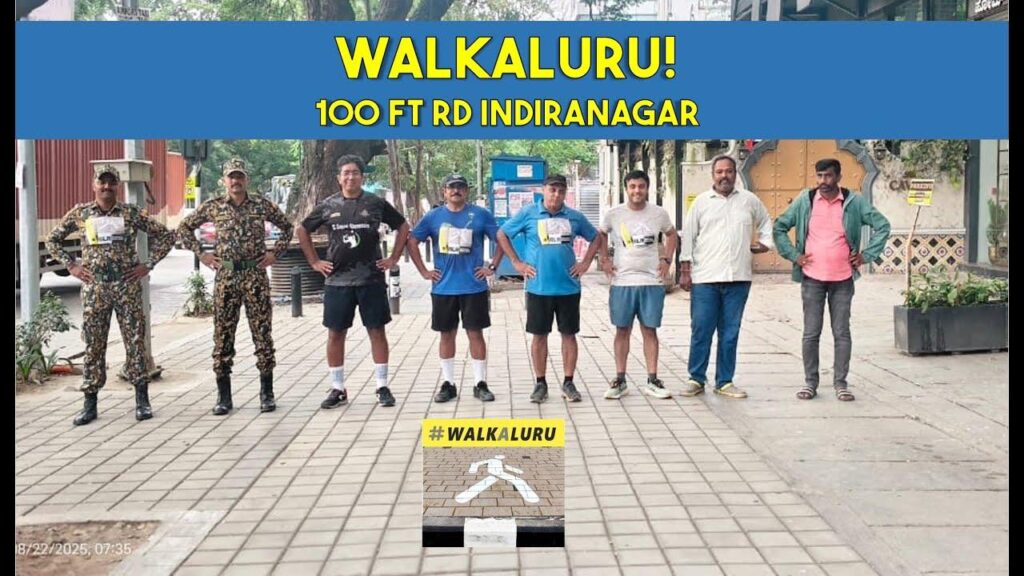In a bold initiative to reclaim the city’s public spaces and enhance urban livability, residents and civic officials in Bengaluru are joining forces to transform the city’s most neglected and polluted areas into pedestrian-friendly zones. Dubbed “Walkaluru,” this grassroots movement reflects a growing recognition of the importance of walkability in urban planning, especially in a bustling metropolis grappling with traffic congestion and environmental challenges. With a focus on community engagement and sustainable design, the initiative aims not only to restore access to the city’s waterways and parks but also to encourage a cultural shift towards more active and environmentally conscious transportation choices. As Bengaluru embarks on this ambitious journey to reinvigorate its streets, the collaborative efforts of its citizens and local authorities signify a hopeful step towards a cleaner, greener city that caters to both residents and visitors alike.
Revitalizing Bengaluru’s Public Spaces Through Citizen Engagement
Bengaluru, once celebrated for its vibrant green spaces and thriving urban environment, has faced the challenge of neglected areas that detract from its livability. However, citizen-led initiatives like ‘Walkaluru’ are breathing new life into the city’s forgotten corners. By fostering collaboration between residents, local NGOs, and civic officials, this grassroots movement is transforming unattractive, neglected locations into inviting walkable spaces that reconnect communities and enhance the urban experience.
Through community workshops, design competitions, and cleanup drives, participants are empowered to take charge of their neighborhoods. Notably, the initiative promotes:
- Art installations by local artists that reflect the culture of the area.
- Improved lighting and seating arrangements to encourage public usage.
- Green zones with native plants to support local biodiversity.
As these once-derelict spots evolve, they not only offer aesthetic improvements but also foster social interactions, thereby strengthening community bonds. The ethos of ‘Walkaluru’ emphasizes that inclusive urban planning, driven by the people rather than solely by officials, can catalyze sustainable development that meets the needs of its citizens.
| Key Components of Walkaluru | Status |
|---|---|
| Community Workshops | Ongoing |
| Design Competitions | Next Month |
| Cleanup Drives | Weekly |
Collaboration Between Civic Officials and Residents Drives Cleanliness Initiatives
The initiative to restore walkability in Bengaluru’s most neglected areas has blossomed through a dynamic collaboration between civic officials and proactive residents. Grassroots movements have empowered citizens to directly engage in cleanliness initiatives, fostering a spirit of shared responsibility towards urban upkeep. This partnership has allowed for the implementation of various sustainable practices, creating a ripple effect that encourages others in the community to take ownership of their surroundings. As a result, locals have started organizing regular cleanup drives and tree plantation events, leading to visibly cleaner streets and a revived sense of community pride.
To further this collaborative effort, civic officials have facilitated platforms for residents to voice their concerns and participate in planning efforts for their neighborhoods. Key components of this partnership include:
- Regular Workshops: Educational sessions that teach residents about waste management and hygiene.
- Community Feedback Loops: Channels for citizens to share their observations on cleanliness and suggest improvements.
- Joint Action Plans: Collaborative strategies developed to tackle specific cleanliness issues in different locales.
A recent survey indicates that areas revitalized through resident-civic collaboration have seen a reduction in littering incidents by up to 40% over the last few months. The table below illustrates the effectiveness of these initiatives in various neighborhoods:
| Neighborhood | Percentage Reduction in Littering | Community Engagement Events |
|---|---|---|
| Kotagally | 40% | 5 |
| Shivaji Nagar | 35% | 4 |
| Indiranagar | 50% | 6 |
This synergy between civic officials and local residents is pivotal in driving long-lasting changes in the city’s cleanliness standards, making Bengaluru a model for urban rejuvenation across India.
Strategies to Enhance Walkability in Bengaluru’s Declining Areas
As Bengaluru grapples with the challenge of revitalizing its declining areas, various stakeholders are coming together to implement innovative strategies aimed at enhancing walkability. Central to these efforts is the engagement of local communities who are actively participating in clean-up drives, pedestrian advocacy, and urban planning discussions. Citizen-led initiatives are fostering a renewed sense of ownership among residents, turning neglected spaces into vibrant pathways. To achieve this, participants are encouraged to focus on the following key aspects:
- Public spaces enhancement: Transforming vacant lots and underutilized areas into parks and plazas.
- Safe pedestrian infrastructure: Installing proper sidewalks, crossings, and signage to bolster pedestrian safety.
- Street furniture and amenities: Adding benches, litter bins, and lighting to create a user-friendly environment.
Civic officials play a crucial role in providing the necessary support and resources for these initiatives. Collaborating with urban planners, they are looking into redesigning roadways and integrating pedestrian-friendly zones into the fabric of the city. Data-driven assessments are being conducted to measure foot traffic and identify the most frequented areas, guiding improvements effectively. Essential strategies include:
| Strategy | Objective |
|---|---|
| Community Workshops | Foster dialogue and collaboration between residents and officials. |
| Walkability Audits | Assess current conditions and prioritize improvement areas. |
| Awareness Campaigns | Educate the public on the benefits of walkable neighborhoods. |
The Conclusion
In conclusion, the collaborative efforts of citizens and civic officials in transforming Bengaluru’s neglected areas into walkable spaces exemplify a model of community engagement that can inspire other cities facing similar challenges. As ‘Walkaluru’ takes root, its success not only highlights the importance of sustainable urban planning but also underscores the power of collective action in reclaiming public spaces. By prioritizing pedestrian-friendly initiatives, Bengaluru is paving the way for a cleaner, more accessible environment, fostering a sense of community and enhancing the quality of life for its residents. As this initiative continues to evolve, it serves as a hopeful reminder that when citizens come together, meaningful change is within reach.
